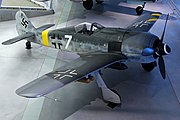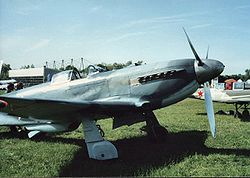
A Review of the Lysander III - a remarkable new kit by Eduard.

Lysander was a gifted Spartan general who defeated Athens in the 4th Century BC - how that relates to the ungainly aircraft produced by Westland Aircraft Company for the Royal Air Force, beginning in the mid-1930s is something of a mystery. Certainly, even at it's best, the "Lizzie" was never intended for aggressive combat operations.
It is more-or-less axiomatic that generals prepare to fight the last war, rather than the next war, and in the Depression-era 1930s, far too many generals prepared to re-fight the deadlocked trench warfare of 1914-1918 - in fact, one reason that the Germans did so well early in World War II is that their generals, having lost the last war, looked for alternatives to trench warfare, and more-or-less discovered Blitzkreig. Oddly, however, it was a few gifted innovators in the Royal Army who "discovered" the signature element of the Blitzkreig - combined-arms tank warfare - in exercises on Salisbury Plain in the late 1920s. But while the British generals ignored the lessons, a young German officer, Heinz Guderian, paid close attention, and put it to work a decade later to lead Hitler's legions to victory in Western Europe.
In the 30s, though, most generals planned to re-fight the last war, and developed the technology needed to win that fight. Infantry-cooperation tanks such as the British Matilda and the French Char Bis had near-impregnable armor along with weapons more adapted to fighting entrenched soldiers than highly-mobile tanks - whereas the Germans created lighter, faster, more mobile tanks well-suited to fighting other tanks. This perspective also translated into aircraft design.
When it came to aircraft, many countries produced Lysander-like aircraft - big, relatively powerful aircraft designed to "cooperate" with ground forces. They were powerful - for instance, the Lysander used an 850 hp Bristol Mercury engine - and they were big. The Lysander, for instance, had a wingspan of 50 feet and it's take-off weight was more than three tons.

In the US, the equivalent was the even-larger North American Aviation O-47 (3.5 tons, 975 horsepower); and in Germany, the Henschel HS-126, which was nearly identical to the Lysander in size, overall layout, power and performance. What these had in common was the belief that "army cooperation" involved conducting armred reconaissance over the enemy's trenches, usually with heavy fighter aircraft coverage. These planes were not intended to fly without escort.
However, the second world war taught a different lesson - instead of big, heavy "targets" designed to track activities over enemy trenches and fixed fortifications, front-line reconaissance in mobile combat needed to be conducted by light spotter aircraft that could land in the field - or carry the commander over the terrain ahead. In fact, many front-line commanders became pilots - both Rommel and Eisenhower were able to fly light aircraft, and frequently did.
The German flew the Fiesler Fi-156 Storch, an ungainly and awkward-looking two-man aircraft specially designed with a variety of sophisticated high-lifte devices that enabled it to land and take off in incredibly-short distances over unprepared "runways" - often dirt roads or fairly level pastureland.

The US and the RAF took a different approach - they took light civilian two-man aircraft "off the shelf" and turned them into front-line observation and liaison aircraft. The US Air Corps "drafted" the Piper Cub, the Taylorcraft and their light-plane stablemates, while the RAF used the largely similar Auster. After the Battle of France in May and June, 1940, no major military force used heavy, powerful "Army Cooperation" aircraft - at least not for the combat missions these planes had been built to fulfill.
The Lysander - a sophisticated, powerful and expensive aircraft - had been designed to help win the last war, and was incapble of fulfilling its over-the-front-lines mission in the Second World War. In the US, this meant that the O-47 was built in very few numbers and quickly retired from anything but safe, Stateside second-line duties.
But the RAF still had a lot of Lysanders - and dared not shut down their production lines as long as the aircraft could be profitably used for some mission. With France occupied and British forces driven from the continent, a sudden need arose to clandestinely transport "Special Operations" forces into France and to bring out shot-down pilots, "blown" secret agents and others more valuable alive and in England than dead or in the Germans' hands. Several thousand Lysanders were built and used throughout the war, and in almost every combat zone.
Lysanders were also sold or given to several other countries, including the US Army Air Force - where it was used as a target tug - Portugal, India, Estonia ... and Finland. The Lysander in Finnish service is the subject of Eduard's latest "Limited Edition" kit, the "
Lysander Mk. III in Ilmavoimat Service." Finland's two wars with the Soviet Union - the "Winter War" and the "Continuation War" (which ended when the Finns signed a separate peace with the USSR and declared war on its former ally, Nazi Germany). Because Finland did not have indigenous light Piper Cub-like aircraft, and because the war with the Soviets tended to be rather static - battling between Leningrad and Helsinki in the Karelian Peninsula - the Lysander still had a role to play, and in combat, it did it's job reliably (if unspectacularly) - observing enemy formations, dropping light bombs to disrupt those formations, and - as a utility aircraft - do whatever else was needed.
This Limited Edition kit has it all - two sprues of exquisitely-molded gray-plastic parts, a separate sprue of crystal-clear parts, a PE fret, resin parts - even masks that help when it comes to painting the metal framework on the clear canopy.
I've built many of the Lysander kits that have been on the market, and - no surprise, this is the best of the lot, by far. Eduard knows that some modelers like to build models - instead of a engine-like blob, for instance, they give you a crankcase and nine individual cylanders, as well as a wiring harness and an exhaust system that gets the job done. The visibile internal structure is just that - visible. The machine guns look like guns, not gun-like lumps of plastic. The propeller features individual blades, which must be properly afixed to the hub. They even include 15 parts that were intended for other versions of the Lysander released by Gavia or Eduard - these parts will be welcome additions to any modeler's spare-parts box.
As with many "limited production" kits coming out of Eastern Europe, there are no locating holes and pins - builders need to take the extra step of dry-fitting parts and making minor adjustments to ensure proper fit ... and of course, some of the parts have a bit of flash ... but nothing any modeler worth his putty can't handle.
I am going through my "Finnish" phase, building everything I can find that flew in the Winter War and the Continuation War. I have done this several times before, in part because the Finns had a rare gift for taking hand-me-down aircraft nobody else wanted (or thought of as front-line combat aircraft) and turned them into battle-winners.
For instance, the Brewster Buffalo - decimated by the Japanese in Malaya, the Dutch East Indies and over Midway Island - proved incredibly effective against far more modern Soviet aircraft - including those made in the West and easily a generation later in concept and design than the Buffalo. The Blenheim - which in RAF service was one of the most efficient ways of turning highly-skilled British bomber crews into German POWs - was, in the hands of Finnish pilots, remarkably successful in its intended role. Other aircraft long-since obslolete in the hands of more well-equipped air forces fought well and effectively in the hands of the Finns - the Curtiss H-75 (in US service, the P-36 - the father of the P-40) and the Morane MS-406 joined the Buffalo and successful air-to-air combat over higher-performance Soviet aircraft.
Oddly, the Soviets were also strangly gifted in turning "also-ran" aircraft into war winners. Some of the Soviet's must successful combat aces scored against the best Luftwaffe had to offer while flying the P-39 Airacobra, a late-30s "transition-era" aircraft that was a mediocre place-holder when used by the US Army Air Force - holding the line in the Southwest Pacific and in North Africa until really "modern" aircraft - P-38 Lightnings, P-47 Thunderbolts or P-51 Mustangs - could be brought into service and meet the Germans and Japanese on more equal terms. While these US pilots were eager to fly almost anything else except the Airacobra, many of the Soviet Union's best pilots demanded more "Kobras," knowing that in the right hands (theirs), it could easily "best" even the latest German Bf 109s and Fw 190s, right up to the fall of Berlin in 1945.
Go figure.
The Finns were the same - they flew mid-30s-era P-36s, Moranes and Buffalos right up till the end of the war, and never lost their edge over skilled and well-equipped Soviet pilots.
And while the Lysander wasn't a front-line fighter aircraft, it was - in the hands of the Finns - an effective combat aircraft right up to 1945. And like the Buffalo and the Morane, it was so ugly that it is in some ways attractive. If you want something odd and ungainly in your collection, this Eduard kit is one you ought to consider.
History: The Lysander was the first British airplane stationed in France during World War Two but was soon found to be vulnerable because of its relatively slow speed. Withdrawn from frontline service, this two-seat, high-winged monoplane would soon become famous for its nocturnal flights into occupied Europe, dropping supplies and agents behind enemy lines.
The Lysander was built by Westland as an army co-operation aircraft at the request of the RAF. The first prototype was flown on June 15, 1936, and a contract for 144 more was signed. The Lysander began its service with No. 16 squadron of the RAF in June of 1938. The Lysander also saw service with France, Turkey and Ireland. Apart from dropping spies and equipment into occupied France, the Lysander also served as a target tug, and performed invaluable service during air-sea rescue operations over the English Channel.
The Lysander was also built under license in Canada, where 225 were constructed by the end of the war. There are approximately 20 surviving Lysanders today, all but one having served with the Royal Canadian Air Force (RCAF). [History by David MacGillivray]
Nicknames: Lizzie; Flying Carrot
Specifications (Lysander III):
Engine: One 870-hp Bristol Mercury XX nine-cylinder radial engine
Weight: Empty 4,365 lbs., Max Takeoff 6,318 lbs.
Wing Span: 50ft. 0in.
Length: 30ft. 6in.
Height: 14ft. 6in.
Performance:
Maximum Speed: 212 mph
Ceiling: 21,500 ft.
Range: 600 miles
Armament: None











 Holy Hellcat, Batman!
Holy Hellcat, Batman!
















